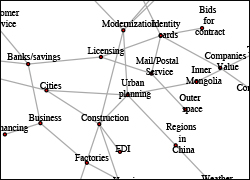Monitoring Political Networks, Censorship, and Propaganda in China
Researcher: Molly Roberts (UC San Diego)
Location: China

This project will develop an infrastructure for automated information extraction, storage, retrieval and analysis of millions of web-accessible documents produced by the Chinese news media, public, and government, entering these documents into a novel data-management system so they can be efficiently accessed.
The team will develop methods that allow for real-time analysis, detection, and updating of relations between political leaders, propaganda, and strategy from these sets of documents. Analysis of this data will be made available to the public in an interactive visualization tool, allowing policymakers and academics to better understand the internal workings of the Chinese government.
It is well known the Chinese government uses the coordination of articles across newspapers as a primary method of government propaganda, but also for omitting reports of sensitive events that could damage the image of the Chinese government. Such propaganda will point to topics and issues that are most important to the Chinese government, providing clues to the government’s agenda.
Identifying and classifying relationships among leaders has long been a central challenge in the analysis of Chinese elite politics. The data will allow us to track when, where and how much different political figures appear together in media reports to generate new, more empirically grounded maps of personal and political associations among elites.
Large-scale analysis of this data will allow researchers to:
- conduct real-time detection of political propaganda,
- identify omission of sensitive topics in Chinese news media, and
- conduct dynamic detection of political associations among elites.
The combination of these methods will allow mapping of emerging governance trends and political strategies in China. Spatial and temporal variance in governance discourse and outcomes offers important clues about the underlying configuration of political forces in China. A combination of text analytics and named-entity recognition techniques will capture differences across provinces and over time in policy formulation and implementation that may signal political cleavages.
An initial dataset of 2,101 visits by Chinese officials to firms in 2012 and 2013 has been created.
This allowed researchers to explore how a change in Party policy at the end of 2012 discouraging these visits affected official behavior in 2013. While we see similar numbers of visits overall in 2012 as compared to 2013, the types of institutions that officials visited in 2013 are very different than those visited in 2012. Officials were less likely to visit private firms in 2013 and more likely to visit government institutions, state-owned enterprises, or government-funded work units. This method measures a shift in government priorities after the change of power from Hu Jintao to Xi Jinping.
In the next stage of the project, researchers will identify all visits from 2014 to 2017.


